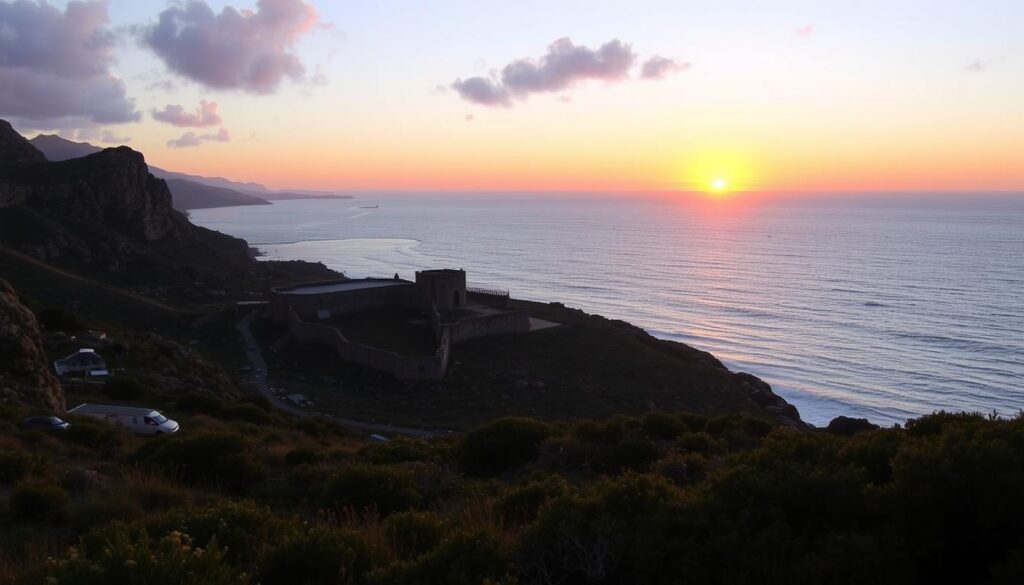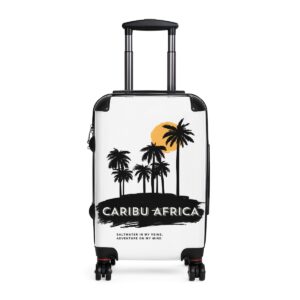Robben Island is a key historical site off Cape Town’s coast in South Africa. It was used as a prison and a place of banishment for about 400 years1. The island is 1.9 square miles (5 square kilometers) big1. It’s also home to many animals, like 25,000 rabbits and 132 bird species, including African Penguins2.
Key Takeaways
- Robben Island is located 4.5 miles from Cape Town’s beaches1.
- The island has a total area of 5.18 km²3.
- Robben Island has served as a place of imprisonment for approximately 400 years1.
- The facility operated as a prison until 19911.
- Visitors can take a guided robben island tour to explore the island’s rich history of robben island.
- The island is a UNESCO World Heritage Site, and visitors can learn about its significance in the context of cape town robben island.
- Robben Island is home to a diverse range of wildlife, including 132 species of birds2.
Overview of Robben Island's Significance
Robben Island is a key historical site, located off Cape Town’s coast. It was a maximum-security prison during apartheid, where Nelson Mandela was held for 18 years of his 27-year sentence2. Now, it’s the Robben Island Museum, showing its past and the fight for freedom and equality.
The island is more than just a prison’s history. It stands as a symbol of resistance against apartheid. It shows the human spirit’s strength in hard times. In 1999, it was named a UNESCO World Heritage Site, honoring its cultural and historical value4.
A Symbol of Resistance Against Apartheid
Robben Island’s story began in the 17th century, as a Dutch convict station4. It was also a leper colony and a military base in World War II. Its history and culture make it a must-see destination.
UNESCO World Heritage Site Status
As a UNESCO World Heritage Site, Robben Island is celebrated for its cultural and historical worth5. It has historic buildings like the Maximum Security Prison, where Mandela was imprisoned. The Robben Island Museum also tells the island’s story. Visitors can take a ferry to explore these sites and learn about its history and significance.
The Historical Context of Robben Island
Robben Island’s history is rich and complex, starting with the Dutch using it as a prison in the 17th century6. It’s about 5 miles from South Africa’s mainland6. Its past is deeply connected to South Africa’s troubled history. Visitors can take a cape town ferry to robben island to learn more about its history and importance.
The island stands as a symbol of resistance against apartheid. Its robben island history is both fascinating and complex7. Some important facts about Robben Island include:
Notable Prisoners of Robben Island
Robben Island is known for its connection to Nelson Mandela, who was imprisoned there for 18 years3. His life story is filled with courage, resilience, and determination. It continues to inspire people everywhere. A robben island tour lets you explore the island and learn about its history, including Mandela’s time there.
Visiting nelson mandela prison on Robben Island is a moving experience. It gives a look into the lives of those who fought apartheid. The island’s history shows the human spirit’s strength in the face of adversity. It’s a place everyone should see to understand the fight against apartheid and the human spirit’s power3.
| Notable Prisoners | Years Imprisoned |
|---|---|
| Nelson Mandela | 18 years |
| Kgalema Motlanthe | 10 years |
| Jacob Zuma | 10 years |
The Journey to Robben Island
Here are some key things to keep in mind when planning your visit to Robben Island:
Visiting Robben Island is a unique and enriching experience. It offers a look into South Africa’s complex history. With its rich history and stunning beauty, Robben Island is a must-see in Cape Town10.
What to Expect on a Guided Tour
A guided tour of Robben Island is a unique and moving experience. It offers a glimpse into the island’s complex history. Visitors see the prison cells, including Nelson Mandela’s, and learn about daily life for prisoners.
Many guides are former inmates themselves. They share their personal stories and experiences. This adds depth and authenticity to the tour12.
The prison guide is usually a former prisoner. They share personal stories of incarceration. This enhances the educational experience13.
The robben island museum is a key part of the tour. It provides a wealth of information about the island’s history and significance. Visitors can buy robben island tickets in advance to secure a spot on the tour. With over 100 people on the boat journey from Cape Town to Robben Island12, it’s a popular destination for history and human rights enthusiasts.
Understanding the Legacy of Robben Island
The history of Robben Island is rich and varied. It was once a prison, a leprosy colony, and even a stop for Dutch ships14. Now, it stands as a national monument and a beacon for freedom and equality. The Robben Island Museum offers educational programs and exhibits that help us understand its history and its importance today.
Robben Island’s impact on freedom movements is significant. It was a prison for political dissidents, including Nelson Mandela, who spent 18 years there14. This has made it a powerful symbol of resistance against oppression. Its story has inspired people worldwide to fight for human rights and dignity, and its legacy is still felt today.
Some of the key features of Robben Island’s legacy include:
- Its status as a national monument and a symbol of the struggle for freedom and equality14
- Its impact on freedom movements around the world
- Its educational programs and exhibits, which promote a deeper understanding of the island’s history and its relevance to contemporary issues
The history of Robben Island is complex and rich. Its legacy continues to inspire us today. By learning about the island’s history and its role in freedom movements, we can appreciate the importance of fighting for human rights and dignity. The Robben Island Museum’s programs and exhibits are a great way to learn more and inspire future leaders to continue the fight for freedom and equality6.

Visiting Robben Island: Essential Information
Here are some important tips for your visit:
- Book your tour early to avoid missing out
- Check ferry times and plan your day
- Be ready for changing weather
By following these tips and knowing the robben island tour cost, you’ll have a memorable visit16.
Nearby Attractions in Cape Town
Cape Town is a lively city where Robben Island is found. It has many exciting places to see. After visiting the Robben Island Museum, you can go to the bustling waterfront. There, you’ll find amazing views, lots of restaurants, and shops for everyone15.
The city also has a rich history and culture. You can visit museums, galleries, and historical sites. These places show off South Africa’s history and culture.
Some top spots to check out include:
- The V&A Waterfront, a lively area with street performers, shops, and restaurants
- Table Mountain, a famous landmark with stunning views of the city
- The Cape Town Stadium, a modern sports venue that hosted the 2010 FIFA World Cup
Don’t miss the city’s colorful neighborhoods like Bo-Kaap. It’s known for its vibrant houses and rich culture. Cape Town is great for those who love history, culture, and fun15. The cape town robben island ferry ride is close by, making it easy to see more of the area.

Visiting Robben Island and exploring nearby gives you a deep look at South Africa’s history and culture. It’s an experience you won’t forget15.
| Attraction | Description |
|---|---|
| Robben Island Museum | A historical site and former prison, now a significant educational landmark |
| V&A Waterfront | A bustling hub of activity with shops, restaurants, and street performers |
| Table Mountain | An iconic landmark offering breathtaking views of the city |
Conclusion: Reflecting on the Lessons of Robben Island
FAQ
What is the significance of Robben Island?
Robben Island is a key historical site in South Africa. It has been a prison and a place of exile for centuries. It stands as a symbol of resistance against apartheid and shows the human spirit’s strength.
Why was Robben Island declared a UNESCO World Heritage site?
In 1999, UNESCO named Robben Island a World Heritage site. This honor recognizes its cultural and historical value. It highlights the island’s role in South Africa’s history.
What was the role of Robben Island during the apartheid era?
During apartheid, Robben Island was a maximum-security prison for political prisoners. Nelson Mandela was among them. The island’s history as a prison for those opposed to the regime is significant.
What can visitors expect when touring Robben Island?
A tour of Robben Island is a moving experience. It gives insight into the island’s history. Visitors see Mandela’s cell and hear stories from former inmates who guide tours.
How can visitors plan their trip to Robben Island?
To visit Robben Island, take a ferry from Cape Town’s waterfront. Book tickets early, as they sell out fast, especially in peak season. The tour’s cost is worth it for experiencing the island’s history.
What other attractions are located near Robben Island?
Robben Island is near many attractions in Cape Town. Visitors can explore the waterfront, museums, galleries, and cultural festivals. These offer a deeper look into South Africa’s history and culture.


































